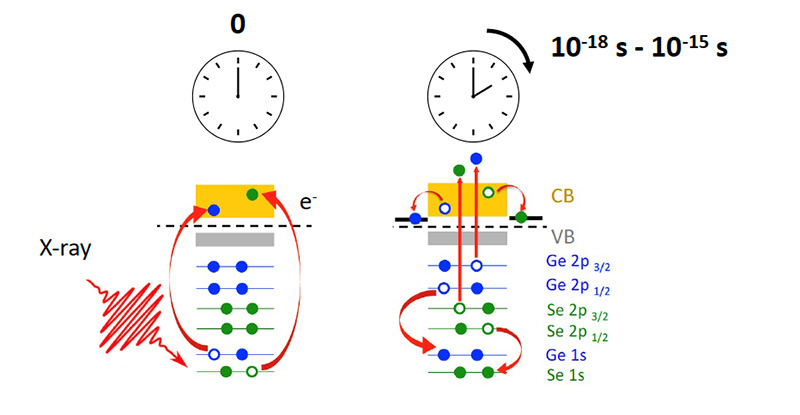The urgent need for low consumption electronic devices calls for new materials which could be operated at fast speed with lower cost. 2D materials hold strong promise to that extent. Here we show that x-ray spectroscopy can capture electrons ultrafast transfer in GeSe, a 2D semiconductor, with chemical sensitivity. The method could help designing novel devices.
Ultrafast electron transfer at the surface of materials are key processes that ultimately determine the functional limitations and properties in potential applications, such as in switching and optoelectronic devices, energy storage and nanodevices.
Probing such phenomenon requires techniques capable of taking snapshot of the electronic properties at ultra-high speed. One can achieve this with pump-probe approach where very short laser pulses are used to excite a material and probe its temporal properties. However, the time-resolution of such a spectroscopy is limited by the laser itself and the whole instrumental setup, which is limited to femtosecond (10-15 s).
Though very fast, this is sometime not fast enough for catching the electrons!
Alternatively, electron dynamics can be investigated by a specific x-ray technique called core-hole clock spectroscopy. This technique uses an intrinsic timescale, the lifetime of a specific electronic level: when a photon interacts with the material, it can kick electrons out of a specific atomic level, leaving a hole in the electronic structure. Soon after, this vacancy is filled by other electrons, producing secondary (Auger) electrons and photons. The deeper the vacancy, the faster the process! This allows electrons dynamics to be elucidated as fast as tens of attoseconds (1 as = 10-18 s) using hard x-rays which can excite deep electrons with very short liftetime (cf. Figure 1). Moreover, it offers the opportunity to investigate the electron dynamics of specific electronic states by properly selecting the incident photons energy, even though it has never been shown before.

Figure 1: core-hole clock Auger spectroscopy in GeSe: The incident x-ray kicks one electron out of the Ge or Se 1s electronic level. A rearrangement of the electrons takes place within few hundreds of attoseconds (10-18 s) following the photon interaction, producing secondary (Auger) electrons which are used to probe the Ge or Se electrons dynamics.
Recently, scientists from LPS (Orsay), LSI (école Polytechnique, Palaiseau), Nanjing Tech University (China) and SOLEIL have demonstrated that germanium selenide (GeSe) semiconductor exhibits electronic states-dependent electron ultrafast dynamics using core hole clock spectroscopy. The measurements were performed on the HAXPES endstation of the GALAXIES beamline at SOLEIL. Owing to the geometry of the experiment (Figure 2a), it was possible to selectively probe the electrons from either Ge 1s or Se 1s levels to specific final states. The results illustrated in Figure 2b-c show that electrons in GeSe react on an attosecond timescale and almost three times faster for Ge than for Se atoms (150 as vs. 470 as).
This observation demonstrates that core hole clock spectroscopy is an efficient way to investigate the selective electron dynamics, complementarily to pump-probe techniques.
The attosecond delocalization time observed in GeSe could advantageously serve to engineer ultrafast devices based on layered semiconductors or artificial structures combining several 2D materials.

Figure 2. The geometry of the sample and incident x-ray in the experiment (a), and Resonant Auger maps of Ge KLL (b) and Se KLL (c), as well as the corresponding spectra taken for electron delocalization time estimation. SA and NA represent normal auger contribution and spectator Auger contribution, respectively.
